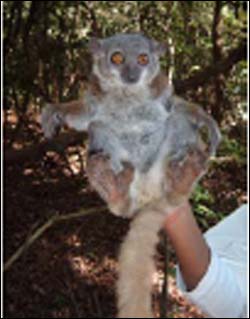Three new species of lemurs in Madagascar

Lepilemur randrianasoli. Photo by: Nicole Andriaholinirina
An international team, composed of Malagasy and European researchers, has just discovered three new species of lemurs, small primates endemic to Madagascar.
The work carried out by this international team has enabled the identification of three new species of lemur based on the characteristics of their mitochondrial DNA : Lepilemur randrianasoli, L. aeeclis and L. sahamalazensis. They were discovered in the West and North West of Madagascar, bringing the number of species of lemur up to 11. This number probably underestimates the diversity of the Lepilemur genus, with other species no doubt waiting to be discovered in other parts of the island.
Lemurs are small, nocturnal, primates native to Madagascar, weighing around 800g. They belong to an endemic genus subject to great pressure by Man either by hunting or by deforestation, where the systematic is still much debated. Primates are divided into two suborders : Prosimians (Lemuroidea) and Simians, the latter comprising both monkeys and humans. Lemurs are classed as Prosimians.
Jointly supported by the University Louis Pasteur (ULP) and by the European Association for the Study and Conservation of Lemurs (A.E.E.C.L.), four Malagasy researchers from the University of Antananarivo have been working in collaboration with several European groups and with two laboratories in particular: the ULP research unit EA3428 “Espèce humaine et primates : variabilité et évolution” (Director Bertrand Ludes) and the “Deutsches Primatenzentrum” in Göttingen. By performing chromosomal and molecular biological studies, these researchers have determined the complete DNA sequence of a mitochondrial protein (cytochrome b), from 68 specimens from 21 different geographical locations. These results were compared to the preliminary chromosomal studies conducted on 99 known specimens. This helped establish a phylogenetic comparison between the species analysed in the current tests and those performed previously, enabling the researchers to define the classification of these lemurs.
The results obtained in this exemplary cooperation are of great importance to the understanding of the diversity and evolution of the Lepilemur genus in Madagascar, and form a solid base for future research programmes concerning the Malagasy fauna and its conservation.
Media Contact
More Information:
http://www-ulp.u-strasbg.fr/All latest news from the category: Ecology, The Environment and Conservation
This complex theme deals primarily with interactions between organisms and the environmental factors that impact them, but to a greater extent between individual inanimate environmental factors.
innovations-report offers informative reports and articles on topics such as climate protection, landscape conservation, ecological systems, wildlife and nature parks and ecosystem efficiency and balance.
Newest articles

New SPECT/CT technique shows impressive biomarker identification
…offers increased access for prostate cancer patients. A novel SPECT/CT acquisition method can accurately detect radiopharmaceutical biodistribution in a convenient manner for prostate cancer patients, opening the door for more…

How 3D printers can give robots a soft touch
Soft skin coverings and touch sensors have emerged as a promising feature for robots that are both safer and more intuitive for human interaction, but they are expensive and difficult…

Oxygen vacancies mediated ultrathin Bi4O5Br2 nanosheets
… as efficient piezocatalyst for synthesis of H2O2 from pure water. As an important chemical raw material, hydrogen peroxide (H2O2) is widely applied in various aspects of industry and life….





















